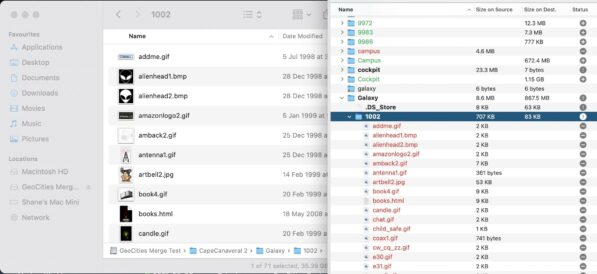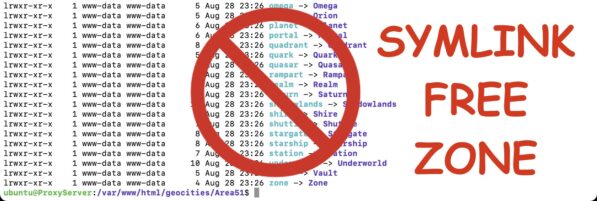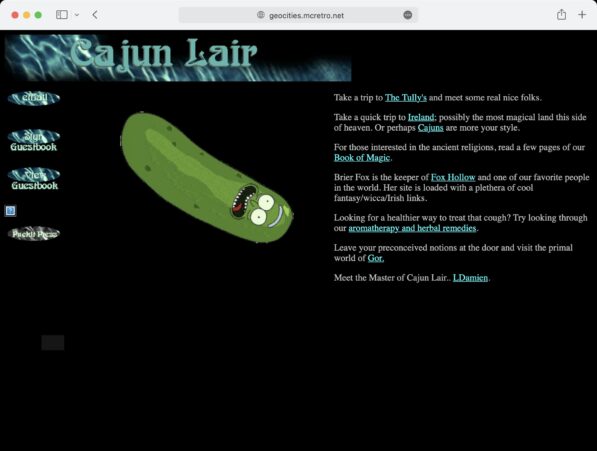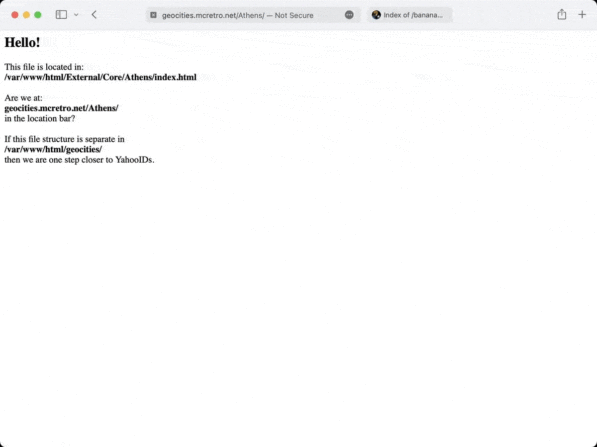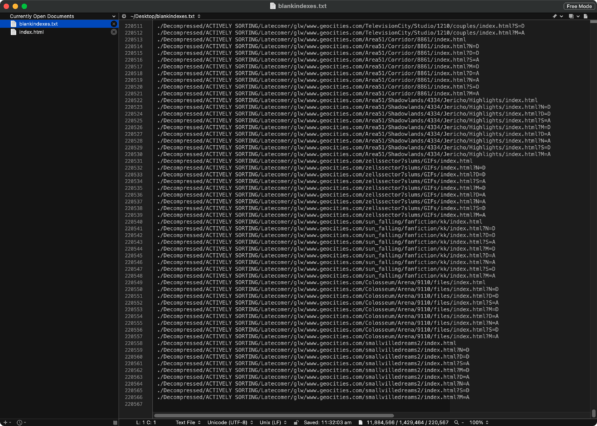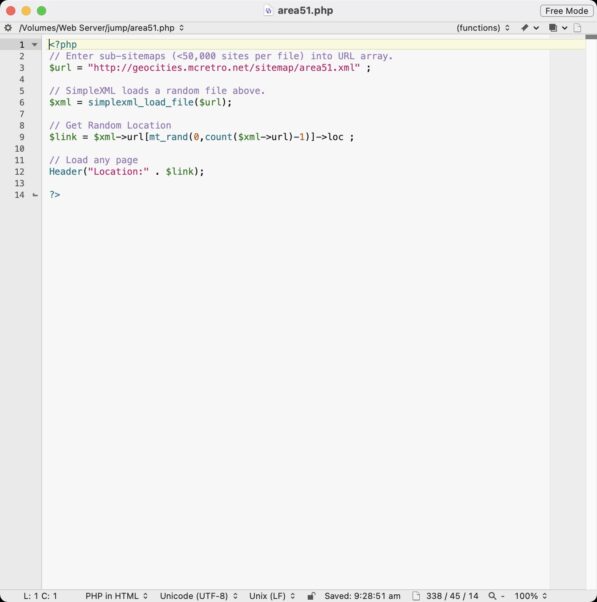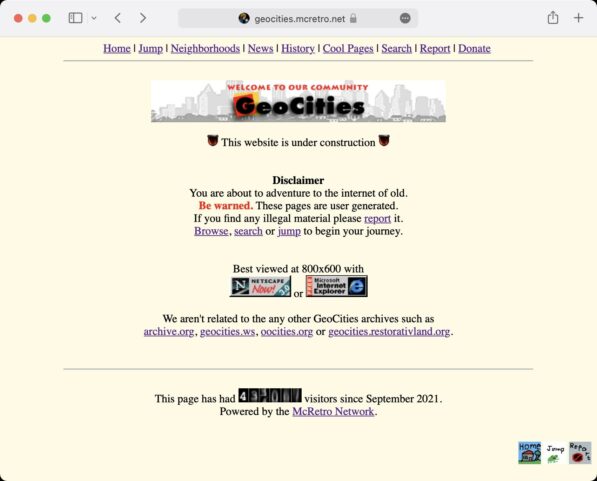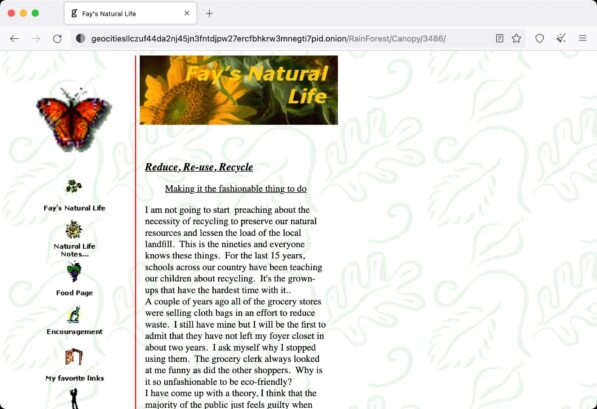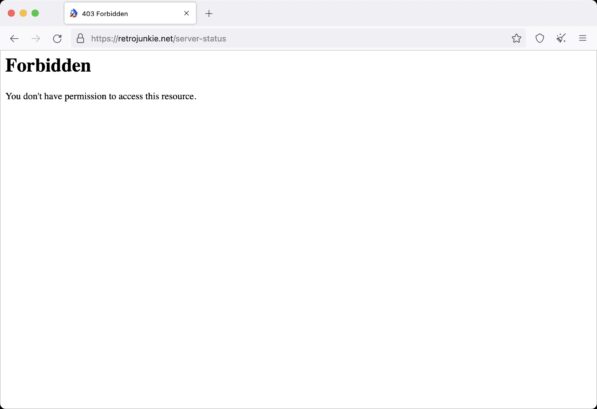This is the original, updated and mostly complete worklog for my GeoCities Reboot at http://geocities.mcretro.net.
1st October 2021
Retro computers need websites to visit. That is what this project is all about. The mass recreation of websites from the GeoCities Archive that are compatible with older web browsers. More to follow…
2nd October 2021
The first thing to take care of is the ability for users to make contact in case they do not want their old GeoCities website reactivated. Enter the Digital Millennium Copyright Act (DMCA), using this we will provide a web form for copyright takedowns. Edit: I have also added the ability to report any illegal content that may be present.
I haven’t had any forms on my website for a long time due to bots and not wanting to have Google reCAPTCHA. hCaptcha is a new one that has appeared and seems to work well. The form I am using is WPForms Lite (free) as it seems to do everything I need it to do.
With that out of the way I can work on the actual content. Yahoo! acquired GeoCities mid-1999 and messed with the city’s structure. This is how GeoCities was structured, for the most part, up until Yahoo!’s acquisition.
Each neighborhood could hold ~9999 websites:
http://www.geocities.com/neighborhood/XXXX
GeoCities got too popular and needed suburbs inside those cities:
http://www.geocities.com/neighborhood/suburb/XXXX
After Yahoo! took over, you could use your YahooID:
http://www.geocities.com/YahooID
So you could have two sites serving the same content:
http://www.geocities.com/neighborhood/suburb/XXXX
http://www.geocities.com/YahooID
Throw in case sensitivity and localisations and it gets messy. Very messy.
That’s why I am only targeting the pre-Yahoo takeover sites operational at this stage. So far I have a very much incomplete staging area at http://geocities.mcretro.net. Only about six of the Athens suburbs are active.
Hardware-wise the main server, mcretro.net, is a headless Raspberry Pi 4 running Ubuntu Server with a reverse proxy to the staging server, geocities.mcretro.net, on a Raspberry Pi 3.
All era-sensitive testing is completed on a MiSTer FPGA running ao486 running Windows 95/98. It has roughly the performance of a 486DX-33. No FPU though… so far it does not like loading the directory listing of 9999 items in Athens very much in Netscape 4.x
Then there’s the modems. I’ve got two Banksia Wave SP56 modems. Internally the boards are marked BT134 REV B and REV F. The REV F is cold as ice when running, REV B is toasty.
We dial between two modems locally thanks to this wonderful guide. I’m using an Cisco SPA112 that I won in a raffle. This is coupled with an Asterisk server on a Raspberry Pi. All the bleeps and bloops without the cost of dialling outside my home.
Among the next steps will be working out how to migrate the data from a Mac APFS (case-sensitive) partition to a Linux ext4 (case-sensitive) partition that can be mounted with appropriate permissions for apache2 on the RPi3 web server.
3rd October 2021
Here’s the type of structure we are dealing with. Just Area51 alone has over 1,000,000 files and weighs in at a hefty 27GB. It also contains suburbs such as Nova, Vault, Nebula, Dimension. The parent directory YAHOOIDS is a bit of mess as it contains account names. That’s one of the reasons I would like to see the easier neighborhoods (pre-Yahoo!) dealt with first. Then I could potentially move on to the chaos Yahoo! created.
And the clone begins! We’re going from an APFS (case-sensitive) partition to an ext4 (case-sensitive) partition. The initial clone to create a backup to rotational media took over 60 hours. There’s almost 1TB of data here and so very many small files. I’ve since upgraded to a set of SSDs, which looks to have been a good investment.
I still need to work out the mounting parameters and whether overriding ownership for all files on a file-system (without actually modifying the file metadata stored on the filesystem) or if I should just make www-data the owner. It takes a loooong time to apply permissions though and I don’t doubt I’ll probably need to reclone the entire data set at some stage. Bindfs is one possible avenue, I’ll have to get reading into how it all works.
This project shouldn’t be completed before the end of October but we should have something to show. I had been working on the modems tying in with the MiSTer since April. Then I accidentally deleted my entire desktop in July and lost a whole heap of notes. My backup was a few weeks old, but much was lost.
While I was busy deleting by desktop, MiSTer FPGA has been progressing allowing support of FTDI’s FT232RL chipset and Prolific’s PL2303. This allows us to connect these serial modems over USB directly into the MiSTer.
4th October 2021 (Part 1)
It’s amazing! It looks like I’ll be able to clone across from my APFS formatted drive with relative ease. However, I will still have to apply the following permissions once mounted, as it is an ext4 formatted drive:
sudo chown www-data:www-data -R *
sudo find . -type d -exec chmod 755 {} \;
sudo find . -type f -exec chmod 644 {} \;
I guess I’ll just have to wait out the 32,000,000 files and directories! I’m using extFS for Mac by Paragon Software to copy between drives.
I am very glad to see that the symlinks survived. Now it’s on to trying to determine the best way to structure the drive. All the links in the table on Area51 should now be active – at least until I try copying more data to it.
4th October 2021 (Part 2)
I don’t think I’ll be going down the bindfs route. It seems to introduce overheads without the benefits. At least not when using ext4 as the target filesystem. So I’ll mount the external hard drive straight into the /var/www/html folder with the following command:
sudo mount /dev/sdb2 /var/www/html/geocities
I had been considering mounting the drive as read only with:
sudo mount -oro,noload /dev/sdb2 /var/www/html/geocities
But then I wouldn’t be able to make any changes on the fly via samba. For reference this was the bindfs command that would have been used, just in case I change my mind down the road.
sudo bindfs -o create-with-perms=0644:a+X,force-group=www-data,force-user=www-data,create-for-user=www-data,create-for-group=www-data /media/geocities_ext/neighborhoods /var/www/html/geocities
It looks like there’s a faster way to change permissions that I wasn’t aware of until today too.
cd /var/www sudo chown www-data:www-data -R * sudo chmod -R a=r,a+X,u+w .
That last line is a replacement for:
sudo find . -type d -exec chmod 755 {} \;
sudo find . -type f -exec chmod 644 {} \;
and then to unmount the partition and play with the data we just run:
sudo umount /var/www/html/geocities
Above is the list of the primary, “core”, neighborhoods. Inside these are subfolders numbered up to 9999. Then there’s also “suburbs”, I guess inside these. Each containing up to… you guessed it 9999 subfolders. There’s around 470GB of data saved here, another ~250GB appears to be for YahooID account names. I am not touching that with the old ten-foot-pole just yet.
As you can see above though, there’s going to be some duplication of data. I need a tool which will be able to compare and merge if identical. Interestingly I have all core folders except Broadway. I guess someone didn’t like theatre!
I’ve been looking at diff for comparing based on md5sum, but it still seems too much work for little payoff. There might be an Apache2 module that helps with this, but first I’ll see what tools are available that are a little more user friendly. First up, Meld.
4th October 2021 (Part 3)
Meld wasn’t too bad, but seemed to be a little clunky and I couldn’t quite work out how to merge two directories including their subfolders. But it did give a great visual representation of the issues we are facing when it comes to case sensitivity.
As you can see above we have CapeCanaveral on the left and capecanaveral on the right. Left has the index.html and the right has a few images (but no index file). A great example, unfortunately the learning curve looked to be a bit too steep for what I needed to do. Meld did not like scrolling very much. It might have been because it was an Intel binary running on Apple Silicon (M1).
Then I remembered, Carbon Copy Cloner might be ideal for this. Carbon Copy Cloner 6 seems to offer comparisons which are nice, but the SafetyNet feature didn’t work as I was expecting.
Downgraded to Carbon Copy Cloner 5 and it works well enough. I don’t know what changed under the hood between CCC 5 and CCC 6 as the settings all looked the eerily similar. We ended up with a “_CCC SafetyNet” which contained only the older of two files when compared side by side.
The SafetyNet appears to be the older files of duplicate data. These appear to be duplicated when CapeCanaveral/XXXX vs capecanaveral/XXXX were captured at different times at the end of GeoCities. A few hours here or a day there isn’t going to make a world of difference in the grand scheme of things here. I’ll hold onto these “_CCC SafetyNet” folders for now though, they don’t use much space. CCC5 gets a big tick of approval.
Beyond Compare was another program worth mentioning, it is very similar to Meld, but feels far more responsive and well built. As you can see the above interface is quite familiar looking but a little overwhelming when trying to decode; definitely one for the power users – not me.
Above is another screenshot from inside Beyond Compare, and you can see the captured data from GeoCities varied by only a few bytes, in the red highlighted section, for some server generated text. This is why merging the case sensitive neighborhoods is such a pain. “CapeCanaveral” and “capecanaveral” both had this html file scraped at separate times. It’s a miracle the Archive Team got what they did!
As you can see above, from the example earlier, CapeCanaveral/1041/, has successfully merged using CCC5. We’ll stick with CCC5 for merging the “core” neighborhoods. The suburbs inside the core neighborhoods will need to be sorted also. Not quite sure how to do that yet. And in the next screenshot we have CapeCanaveral/Galaxy/1002/ now showing a full directory.
Once I work out how to get all the suburbs into their correctly capitalised folders, I’ll need to create symbolic (soft) links to join capecanaveral, capeCanaveral, and Capecanaveral to CapeCanaveral. Unless Apache has a way to help with this issue.
4th October 2021 (Part 4)
Alright, so we’ve had data cloning back and forth. What damage have we done to the permissions and symlinks? Thankfully the symlinks look to be intact – they are denoted by the letter
l
at the start of the permissions. and the letter
d
indicates a directory with
-
indicating it is a file.
I had no idea that this is how they worked. Setting a directory to:
755 (drwxr-xr-x)
and a file to:
644 (-rwxr--r--)
is what I was doing earlier without really knowing. Neat! Anyway, hall redirects to Hall OK in the first image above. I went through and manually tidied up the “Station” folder, so there is no longer a lowercase “station” folder. I’ve created a symlink on my Mac using:
ln -s Station station
Which creates the following new symlink:
Which we can then check in Finder on the Mac, and it appears to be working well.
With symlinks working, we can move onto tidying up before symlinking everything together. The image above shows that there are still multiple folders with different case. I need to unify them as one and then create symlinks in case someone has referenced /symlink/ instead of /SymLink/.
4th October 2021 (Part 5)
Oh, yes! Apache to the rescue with the mod_speling module.
sudo a2enmod speling
We’ve placed the following in VirtualHost configuration file inside Directory tags:
# Case-insensitive CheckSpelling on CheckCaseOnly on
and a quick restart of apache2.
sudo service apache2 restart
Ahh! Wrong permissions are set on the web server. We had used Carbon Copy Cloner 5 to copy back onto “GeoCities APFS Decompressed” from the temporary sparse disk image bundle to maintain the case-sensitivity. We then copied from the APFS partition back onto the ext4 partition with CCC5.
This gave me some weird permissions, 501:dialout against the CapeCanaveral directory.
Turns out 501 is the default User ID for Mac OS. Mystery solved! A quick run of the below commands fixed up the permissions issues and…
cd /var/www sudo chown www-data:www-data -R * sudo chmod -R a=r,a+X,u+w .
Apache’s mod_speling allows us to have the expected, correct capitalisation:
As CapeCanaveral only exists by itself, trying to load the following:
results in…
A redirection to https://geocities.mcretro.net/CapeCanaveral/ … I guess I won’t be needing those symlinks after all thanks to Apache’s mod_speling.
And that’s it for the weekend. Feel free to stop by http://geocities.mcretro.net and test out Area51 or CapeCanaveral. Don’t press anything in Athens though, it isn’t working just yet!
10th October 2021
This weekend I’ve been taking it easy due to giving a blood donation on Saturday. Perfect opportunity to test out the website on as close as I have to real hardware – while live streaming. Interestingly Netscape 4 feels clunkier and slower than Internet Explorer 5. Maybe I backed the wrong horse on this one.
For now I’m going to get the neighborhood list tabled up and cross checked between a few sources and the WayBack Machine.
11th October 2021
Shower thoughts. They hit you with the greatest clarity but rarely make it out. This one survived.
For the past couple of days I have been trying to think about how to get a header to stick at the top of the page to allow “teleport” to another random page, head back to the neighborhood list, etc.
I haven’t been able to use basic php as it would result in the location bar URL simply returning http://geocities.mcretro.net – useless for takedowns or knowing where you are in the archives.
I tried a few things, mostly seeing if there was a way to use javascript to rewrite the location bar URL. In hindsight, I think I may have been thinking about this back-to-front.
Late last night I was looking into the section boxed in red in the above image. It seems to be on almost every archived html page. I went to sleep.
This morning, in the middle of my shower, it hit me. Could the Yahoo! server-generated code be replaced with a new script for inserting a header? Now that I know mod_substitute exists, this might just work.
I needed something big and flashy to stand out so I made a Pickle Rick gif and added the following inside the VirtualHost tags:
Substitute 's|<script language="JavaScript" src="http://us.js2.yimg.com/us.js.yimg.com/lib/smb/js/hosting/cp/js_source/geov2_001.js"></script>|<img src="http://geocities.mcretro.net/pictures/pickle.gif">|i'
And what do we have…
Giant. Spinning. Pickle.
Yes, it’s possible! And when coupled with mod_cache, the substituted result can be saved for later viewing with less strain on server resources. I could possibly use this in several ways:
Back to the first image. In the red box there is also additional, possibly global, code that could be removed or replaced. I know the last image source carries a relatively unique timestamp, which means I may need to use some fancy strings to remove or replace it.
Another issue I remembered was that the pages without an index.html or index.php file that just return a file listing could possibly also use the header / footer feature of Apache2 to insert a similar header / footer.
So for now there is a spinning pickle on all the pages that are up, until a header is added. Definitely check out CapeCanaveral and Area51 to see if you can find any without spinning pickles. What a time to be alive. I better get back to creating the neighborhood pages.
12th October 2021
A quick redesign to make it a little nicer, still a work in progress – it wouldn’t be a GeoCities website if it wasn’t under construction after all.
Being able to teleport or jump to random sites inside the GeoCities archives is going to need a list of all available links to jump to. A sitemap.xml file should help us with that. That will be the database of available links for jumping.
To generate a sitemap we’ll need a… sitemap generator. I’ve decided on the aptly named Sitemap Generator CLI. I decided it would be best to run it on one of the Ubuntu 20.04 servers. Installation was straightforward.
sudo apt update sudo apt install npm sudo npm install -g sitemap-generator-cli
Then the generation of the sitemap.xml file. Unsurprisingly, this will also serve as a sitemap for Google, Bing and others crawling the website for links. Depth of 4 seems to be sufficient to capture the majority of sites in the neighborhoods. Obviously this will not capture all links present but does capture just shy of 300,000.
sitemap-generator http://geocities.mcretro.net --verbose --max-depth 4
After waiting what felt like a few hours, move the sitemap into the appropriate folder:
sudo mv sitemap.xml /var/www/html/geocities/
We now have a sitemap. Next, we need to figure out how to best implement the teleport (Jump™) feature to utilise the sitemap.
16th October 2021
Jump™ implemented.
The code comes from stackoverflow.com. The Jump™ code now runs a server-side script, in PHP, to randomly select a website from the sitemap.xml file. If it weren’t server-side you’d know because the file large at 1.8MB. Downloading that over dialup is going to be very slow!
You can try it here to beam to a random GeoCities website. We still have only Area51 and CapeCanaveral active. Great for fans of X-Files fanfic, not so great for anyone else.
Now we have the code that helps us jump to random sites that is pulled from our sitemap.xml. So where to next? Finding a way to keep a “Home”, “Jump”, and “Report” text or buttons on the majority of sites visited. Initial tests were somewhat successful…
I rediscovered TARGET=”_top” after having my test links as same window. TARGET=”_top” makes links open in the topmost frame, i.e. the full browser tab and window. Lesson learnt!
The current iteration of nav buttons embed into the page through Apache’s mod_substitute. We replace the
</BODY>
tag of the website server-side, not on the client-side browser. No solution was perfect, so I went with the one that causes the least damage.
The above shows issues when using BODY as a place to inject when FRAMESET is present. Substituting the
</BODY>
results in no nav buttons showing because FRAMESET is used in place of BODY tags. While I could inject code into FRAMESET as well, I think it would cause more issues depending on if the FRAMESET contained body tags such as the above sample site code.
I did tinker with having JavaScript overwriting some of the code to inject a nav bar. However, it was not working on the targeted older browsers. The reason? The script always landed outside the closing BODY tag meaning it wouldn’t render on the page.
Loaded the VirtualHost config:
sudo nano /etc/apache2/sites-available/geocities.conf
and inserted the following:
# Insert Home, Jump™ and Report Icons - Works without breaking too much, doesn't show on sites without a closing body tag </BODY>. Substitute 's|</body>|<BR><p align="right"><a HREF="/" target="_top" rel="noopener"><IMG SRC="/pictures/home.gif" ALT="Home"></A> <a HREF="/jump" target="_top" rel="noopener"><IMG SRC="/pictures/jump.gif" ALT="Jump!"></A> <a HREF="https://mcretro.net/report" target="_blank" rel="noopener"><IMG SRC="/pictures/report.gif" ALT="Report"</A></p></body>|i'
We can now jump from most pages – including directory listings (i.e. pages without an index).
In other news, I’ve mostly finished the neighborhood listing. This means if I copy all the files across they will now load up well enough. I’m still working on directory structure though.
Images for sites seem to come from the following pages:
It’s pure chaos.
I’m looking into aliasing some of the data directories for YahooIDs to prevent them flooding the root folder with random usernames. Still trying to work out the best way to achieve that though.
I’ve tidied up the counters and the root substitutes, I noticed a lot more backgrounds work now. Once I merge all the root pictures/images together, we’ll have much better looking sites. Well, perhaps better isn’t quite be the right word.
For now I have removed some of the JavaScript hiding on almost all pages. I couldn’t work out how to remove the geovisit(); code though. Two out of three ain’t bad.
Not much more to report except for some insight into those new Matrix sequels. I’ll keep working away on working out structure on the backend. I need to verify the structure of the neighborhoods against other sources such as Blade’s Place, OoCities.com and Wayback Machine.
Then I’ll need to poke around the YahooIDs, Neighborhoods and pictures spanning three periods: GeoCities, the GeoCities/Yahoo transition and Yahoo. Working these ones out will help determine the best way to mount the external media.
17th October 2021
Here’s the file structure. I want to have External be an external USB SSD to hold all the data from Core (Neighborhoods) and YahooIDs (YahooIDs). Athens is an example of a neighborhood. The YahooIDs, bananaphone, grantshome and jackiluvcatz are examples of usernames. The geocities subfolder contains the HTML I have written up in the past month or so.
There’s a lot of cross over between YahooIDs and neighborhoods. It looks like if you had a page at geocities.com/Athens/4829/ you would have also had geocities.com/jackiluvcatz as a symlink. The page builders that Yahoo (and maybe GeoCities) used seem to have willy nilly used the YahooID over the neighborhood location in referencing images, and other files in your website.
So really I needed two separate locations to meet (parallel and overlapping data) under the root folder where I already had data.
My external hard drive containing all Core and YahooIDs data data is currently mounted at /var/www/html/External/
I attempted to use mod_alias only to find it kind of worked, but not really. Then I came across this incredible idea of having two DocumentRoots. My VirtualHost configuration became this:
DocumentRoot /var/www/html/geocities
<Directory /var/www/html/geocities>
Options Indexes MultiViews FollowSymLinks
AllowOverride None
Require all granted
</Directory>
RewriteCond "/var/www/html/External/YahooIDs%{REQUEST_URI}" -f [OR]
RewriteCond "/var/www/html/External/YahooIDs%{REQUEST_URI}" -d
RewriteRule ^/?(.*)$ /var/www/html/External/YahooIDs/$1 [L]
RewriteCond "/var/www/html/External/Core%{REQUEST_URI}" -f [OR]
RewriteCond "/var/www/html/External/Core%{REQUEST_URI}" -d
RewriteRule ^/?(.*)$ /var/www/html/External/Core/$1 [L]
It worked! Almost perfectly. I found that we would lose the ability to have “athens” be corrected to “Athens” once passed through the rewrite rule. It turns out mod_speling and mod_rewrite are incompatible.
"mod_speling and mod_rewrite apply their rules during the same phase. If rewrite touches a URL it generally won't pass the url on to mod_speling."
One document root (my HTML) and two rewrite rules (Neighborhoods and YahooIDs) were so close to working. Every article I read told me it wasn’t possible, everyone else gave up or threads went dead. I did learn that Microsoft IIS has this issue often when migrating to a Linux host with Apache. Great.
I guess symlinks are back on the menu. I could use:
sudo ln -s Athens athens
This would allow me to have athens corrected to Athens. But what about SoHo, Soho and soho. Let alone the case sensitivity on YahooIDs… Plus there’s a bunch of unmerged case differences. I’ll merge them one day, maybe. mod_speling might negate the need to do that.
There’s too many variations of each YahooID, e.g. bananaphone vs BANANAPHONE and every iteration inbetween to create symlinks for. If mod_speling is broken, then case sensitivity is broken stopping people visiting the second address listed:
It was so close to working. Just the lowercase variations were broken. I even dabbled in rewriting all files to lowercase through mod_rewrite. Nope, that didn’t work at all. Hmmm. Then it hit me. Like a bus. Reverse it.
I know that my created HTML is all lowercase and doesn’t require mod_speling. That means that the “geocities” folder can be ran through mod_rewrite with no consequences of mod_speling being disabled. Great!
# Rewrites for GeoCities (self-made) files. Allows mod_speling to function.
# mod_rewrite does not allow mod_speling to modify / ignore case.
# This is fine on my created files as everything is lowercase.
RewriteEngine on
RewriteCond "/var/www/html/geocities%{REQUEST_URI}" -f [OR]
RewriteCond "/var/www/html/geocities%{REQUEST_URI}" -d
RewriteRule ^/?(.*)$ /var/www/html/geocities/$1 [L]
With “geocities” being taken care of we move on to the contents of the “External” folders. We need their contents to show at:
Simple? Not really. No wonder I got stuck on this so long! The larger of the two folders is going to be YahooIDs. There’s a finite amount of neighborhoods, so core will have less items. Sounds like I need to symlink Core folders into YahooIDs so they both display at root in http://geocities.mcretro.net/ – symlink activate!
sudo ln -s /var/www/html/External/Core/* /var/www/html/External/YahooIDs
I could also use the following to force linking in case other symbolic links exist in the YahooID folder. I can’t remember which once I used but the following would have been useful after the first run – and making sure there were no YahooIDs equal to Neighbourhoods…
sudo ln -sf /var/www/html/External/Core/* /var/www/html/External/YahooIDs
-f Force existing destination pathnames to be removed to allow the link.
Now we have an Athens folder inside YahooIDs. Excellent. YahooIDs is now our DocumentRoot. Core (neighborhoods) is symlinked into YahooIDs. My GeoCities HTML landing page is rewritten into / alongside the above two. Three folders feeding into one. Incredible.
I’m hoping you’re starting to see why the GeoCities Archive is such a mess. The backend would have been chaos.
These all redirect correctly:
Also important to check the older links are still working and have mod_speling active:
On that note, we’ll need to move any neighborhoods from /geocities/ to /External/Core/.
It seems that the /geocities/Area51/ rewrite rule has priority over /External/Core/Area51/ – interesting. Throw some case in there and it all redirects correctly though. This might not mean anything at this stage since I need to reshuffle the files around and fix permissions.
Above is the VirtualHost configuration to date. I better get around to moving everything across into final directories for further testing.
UPDATE 1:
These are some other good test cases while trying to get the merging to work as some were present in lowercase and some in uppercase. Ultimately I’ll need to merge all the case variants at some stage.
Exists
http://geocities.mcretro.net/capecanaveral/1020/line/
Doesn’t Exist
http://geocities.mcretro.net/CapeCanaveral/1020/line/
Great links for testing this out:
http://geocities.mcretro.net/CapeCanaveral/1020/line/marsh.gif
http://geocities.mcretro.net/capecanaveral/1020/line/marsh.gif
http://geocities.mcretro.net/CapeCanaveral/1020/index.html
http://geocities.mcretro.net/capecanaveral/1020/index.html
Does mod_spelling work it out? If yes, mod_spelling is working well to merge the mush of uppercase and lowercase.
UPDATE 2: Copied all the neighborhoods (core) across and a few usernames (yahooids) – it looks like it might be working. I’ll rebuild the sitemap.xml file tonight. It should wind up being pretty big. Then jump should teleport across any page that is available!
19th October 2021
Jump™ is working, however the server does not like having to parse a file that is 15MB everytime the link is clicked. There’s over 280,000 links indexed. Yikes! That’s before I add 100,000+ user folders… That’s a lot of files.
What I can possibly do to speed it up a little is to split the sitemap into multiple files. Then the jump PHP script could call on one of the sitemaps at random, and pick a random URL inside the sitemap called upon. Of course you could just pick a suburb from the neighhborhood section and explore that way too.
Now that I’ve got everything redirecting to the root where it should be, I’m coming across some issues. This is one of them. This is mod_speling in action, trying to work out what address I was supposed to go to. I gave it capeCanaveral (invalid, non-existent) instead of CapeCanaveral (valid, exists) or capecanaveral (invalid, non-existent).
As you can see from the above gif, marsh.gif is present in only one and it mod_speling failed to splice the two directories together. This might be a by-product of the way the DocumentRoot and mod_rewrite was configured earlier… I guess it doesn’t matter too much for now. I will need to find a way to merge the lower case and upper case variations on directory names eventually.
Next steps will be capturing more core (neighborhoods) directories to merge from the YahooID folders. The data dump included a few extra sources apart from the main files, I’ll need to get these into the mix.
The next step after that will be sorting out the structure of the root pictures and images folders. These are pretty important as some people hot-linked directly to the root source files which aren’t all present yet.
I won’t be able to work on this too much until the weekend again, but it does give some food for thought until then.
23rd October 2021
I know I said I wouldn’t do too much during the week but a few things did click together. In preparation for merging the neighborhood case differences with rsync (or Carbon Copy Cloner) we’ve made some big strides in the past week.
Here’s the more exciting things:
- Found and removed all index.html files from directory listings.
- Removed 0 byte files, removed 0 byte folders (in that order).
- Started to clean up some of the redirection looped files and folders.
- Less than 1TB of data is present now.
- Symlinks were all deleted (again) – we need mod_speling to work properly.
- Sitemap has been created successfully and is now split into smaller chunks.
- The jump script now covers all neighborhoods and is a fair bit quicker.
All these will help with the merging of the various data sources together. It’s a bit like Minesweeper before you tinker with the settings to win faster.
The best order for cleaning up the file and directory structure (#2 and #5 above) was:
- Delete .DS_Store files (thanks Mac OS for creating them)
- Delete zero byte (empty) files
- Delete empty directories
- Delete symlinks
The creation of hidden .DS_Store files and directory listing index.html files (see #1) were blocking directories from being deleted as they were not empty. The above image was one of the offending index.html files that were likely autogenerated by Yahoo in order to reduce server load. The cost? They aren’t dynamic anymore. Deleting the index.html files was a tough feat.
As you can see above, these directory listing indexes are missing their icons and are quite boring. They don’t have a lot in common, but their source code shared some unique beginnings. This is one of the files:
<!DOCTYPE HTML PUBLIC "-//W3C//DTD HTML 3.2 Final//EN"> <HTML> <HEAD> <TITLE>Index of /CapeCanaveral/6276/wreck</TITLE> </HEAD> <BODY> <H1>Index of /CapeCanaveral/6276/wreck</H1>
From that we can steal the first part – four lines worth:
<!DOCTYPE HTML PUBLIC "-//W3C//DTD HTML 3.2 Final//EN"> <HTML> <HEAD> <TITLE>Index of
And that’s pretty unique in itself as it narrows down HTML files that have “Index of” in their title. That’s only going to be indexes of directories. Perfect. Another bonus is the !DOCTYPE declaration. HTML3.2 Final (we’re up to HTML5 now). Very handy.
Next up I did some searching to find what command line tool(s) I could use. Enter grep via this post:
grep --include=\*.{htm,html} -rnw '/path/to/somewhere/' -e "pattern"
Grep seemed to work, but it was detecting my three lines as three searches and not stringing them together. So I’d have it return a positive for each line, I need all lines to be considered at the same time. Turns out grep wasn’t good enough. I needed pcregrep.
After playing around with switches and settings and adapting the code to suit my needs. I ended up with this:
pcregrep --buffer-size=2M --include=\index.{htm,html} -rilM "(?s)<\!DOCTYPE HTML PUBLIC \"-//W3C//DTD HTML 3.2 Final//EN\">.*(?s)<HTML>.*<HEAD>.*(?s)<TITLE>Index of " '.' 2>&1 |tee ~/Desktop/blankindex.txt
Firstly, pcregrep has a buffer limit of 20K. Not enough. It outputs errors and messes up my blankindex.txt file. Buffer size booster to 2M. Great!
We only want to include index.htm or index.html files. Decoding -rilM, in order: recursive, case-insensitive, list matches show only, search beyond line boundaries. That last one is important. Followed by a bunch of regex stringing all the lines together. The ‘.’ searches the current folder, so make sure you are in the correct directory when running this.
But that wasn’t enough, I wanted to send it all to a text file for review. Adding 2>&1 sends errors and terminal output to my brand new text file, blankindex.txt, using tee. This resulted in the following:
Excellent, I have a massive list of all the directory listing index.html files I don’t want. 219,060 files. Now to check my work, I checked how many index.html files were present overall. How? Well let’s try to dumb down our search with pcregrep. We’ll look for the following in index.html files.
<HTML> <HEAD>
And we’ll search with this code. This should yield a lot more results.
pcregrep --buffer-size=2M --include=\index.{htm,html} -rilM "(?s)<HTML>.*<HEAD>" '.' 2>&1 |tee ~/Desktop/fullindex.txt
And it did. The original was 12MB at 219,000, the new one was well over 50MB before I cancelled it. There’s definitely a lot of index.html files with both HTML and HEAD tags. Past cool! :+1:
I checked some samples from the blankindex.txt file to make sure I was definitely only removing static directory listings and not user generated content. Everything checked out. Next up, xargs.
xargs -n 1 ls -v < ~/Desktop/blankindex.txt
Whoops. Good thing that had an ls in place of the rm. Apparently white space is not liked by xargs unless enclosed in quotes…
Adding quotes is quite easy using BBEdit as it has a built in grep function. As I just happened to have the knowledge fresh in my memory, I did some grepping to add to the front of each line with the ^ (carrat) symbol and to the end of each line with a $ (dollar) symbol. Done. Now the file should be able to get parsed correctly in terminal (Mac OS).
xargs -n 1 ls -v < ~/Desktop/blankindex.txt
A lot of reading indicated I should have been using the -0 (or –null) flag for xargs. I think it would have saved putting the quotes around each line. But I didn’t, I took the risk and watched it list attributes of files in the blankindex.txt file. I checked for any errors. None. We are go for the final command.
xargs -n 1 rm -v < ~/Desktop/blankindex.txt
It worked. Next stop, clean out some more empty files, folders and .DS_Stores:
find . -name .DS_Store -delete find . -empty -type f -delete find . -empty -type d -delete
We now have a much tidier directory structure for merging and a lack of empty files (or useless files) will prevent collisions when merging folders. We’ll have a look at more case sensitivity, redirection loops, sitemap and jump tomorrow.
24th October 2021
The above video shows the rm command running through stripping static, server-generated index.html files away.
Recapping yesterday:
Onto number three in the list. Cleaning up files and folders that suffered from redirection loops when being harvested by Archive Team.
While looking for empty directories, the longest of the long path lengths appeared. The above image shows an example of this output. The redirection loops (recursive loops) get a little extreme sometimes. For the purposes of this project, as long as they keep below the maximum path length, we are OK.
The above image shows an example of what a typical loop would look like in Finder. At the time of writing the longest one we have is around 220 characters which is more than acceptable. The web crawler / spider would have been going a little insane finding a link within a link that was a link to itself inside a link, inside another link, linked to another link, etc., etc.
Running the following command will show the 10000 longest pathnames:
find . | awk '{print length($0), $0}' | sort -n | tail -n 10000
I’ve run this command a few times now and fixed the loops by deleting duplicated data. One interesting error I’ve come across is seen in the next image.
In particular, take note of;
The correct music.html is the file named music.html.1. However, all the files in the music.html folder are also the same music.html.1 file. It doesn’t seem to happen on every recursive loop, but has happened enough for me to take note on how to fix it.
Deleting these has helped dip the entire decompressed data set below the 1TB mark. Some of those loops were big, causing folders to inflate to gigabytes. I should really run a search on folder size to detect any excessive utilisation of hard drive space. Low priority for now. But it does mean I can backup onto a 1TB drive/partition in full now. Lucky!
Touching on Apache’s mod_speling again, symlinks have all been removed from the local drive (not the server facing one, yet). If symlinks are present they have been confirmed to mess with mod_speling. This prevents correct redirections from happening. It’s more the nested directories that have issues. For example take:
/Athens/olympus/
is not redirected to
/Athens/Olympus/
as
/Athens/olympus/
exists as a symlink. This causes issues for mod_speling as it can’t resolve issues like this as it sees two olympus folders, even though they are one and the same.
One of the goals is to have everything in the correctly capitalised folders as GeoCities would have wanted it – Area51, SoHo, SiliconValley, etc. Any incorrect case will likely cause issues with mod_speling, breaking the ability to redirect correctly or locate source files – such as images and midis.
This means symlinks are off the menu again. They will only be used on the live server to fold the neighborhoods (/core/) into the much larger YahooIDs (/yahooids/). We need to give mod_speling the opportunity to thrive. We can always recreate symlinks if required as a last ditch effort.
301,000 pages are now in the sitemap.xml split over seven files. That’s with a depth flag of 4. I’m scared to think how long it would take if we did unlimited depth following every link found. I should try it one decade. Anyway, now that the sitemap is working, it’s time to fix Jump™!
Jump™ loads faster now and the stress on the weak Raspberry Pi 3 CPU is less when parsing the smaller sub-sitemap files. The amount of code I am running through the command line is fantastic.
I’ve been using awk, grep (and pcregrep for multiline matching), find, rsync and xargs. I think I am getting better at regular expressions (regex). Regex are extremely powerful provided you are using the right tool. I may have nearly wiped my desktop out… a second time… with an rm command. This time around I was quite careful with what I was doing with these backupless, work-in-progress files.
The Future
The next steps over the week will be to continue sorting out the pictures and images from the rest of the decompressed data. I’ll be tidying up the YahooIDs to remove any core folders, such as Area51, Hollywood, etc. They can’t be left in the YahooIDs folder. That would cause pretty big issues when, for example, /core/Area51/ tries to mount at the same point as /yahooids/Area51.
I also need to continue to think about the best way to serve the images. Currently there are many locations images were stored at, including international sites. I need to work out the best way to write that into Apache’s mod_substitute. A sample of the website addresses is below:
We create a simple /images folder and put the domains in our root directory and would look something like this:
I think this is something like what Yahoo did when they took over in mid-1999 and again after a brand refresh in the 2000s. For the immediate future though… a backup.
Creating a snapshot of the progress so far, to rotational media, is a good idea. It should finish late tonight. I’ll then be able to work on merging neighborhood (core) data together. Not making a backup at this point could easily be disastrous. One more week and we should have a clearer picture of how everything looks.
30th October 2021 (Part 1)
For the past week, my primary goal has been to merge all the core data together, avoiding copy blocks as pictured above. I’ve been mostly successful at this, although I might have had to call upon the backup from last week a few times. It’s very easy to enable autopilot and accidentally overwrite all of Heartland by replacing instead of merging. Thankfully, that’s now water under the bridge and we have arrived at…
That’s right, the core has been merged
The neighborhoods are all in one place and now have correct TitleCase (see above). MotorCity is no longer motorcity or motorCity. Trying to visit an incorrect title now invokes Apache’s mod_speling to boot you into the right directory. Previously when we had a mish-mash of lowercase, and uppercase letters it would result in some quirky behaviour.
YahooIDs have been cleared out and contain only usernames now. YahooIDs have not had their case switched to lowercase as I haven’t found the right command to do it… yet.
The pictures are (mostly) merged
In the image above we can see clipart tiled backgrounds making an appearance which makes text a lot easier on the eyes. I’ve been thinking about implementing a calibration page to help get the best 800×600 experience on modern browsers as some of the tiling tends to, well tile I guess, vertically making the page look like sloppy construction.
There’s now a GeoCities favicon.ico in the title bar. It looks like the favicon standard wasn’t around until the late 1990s when GeoCities rebranded, just prior to Yahoo! takeover.
Since just before 7am we have been rebuilding the sitemap.xml to reflect the lack of empty folders and blank index.html files. This will likely take the rest of the day.
After this has completed, I’ve allocated some time to spend browsing the GeoCities via Jump™. I’ll live stream this browsing session over one of my YouTube channels. This will be done with the MiSTer which feels like a 486 running at 33MHz. Armed with Windows 98 and Internet Explorer 5.0, I’ll dial into the world wide web (WWW) through my two Banksia SP56 modems at ~28.8k. I’ve got an MT32-pi hooked up so I’ll be rocking out to any MIDIs I come across. Stay tuned! :city_sunrise:
30th October 2021 (Part 2)
The sitemap generation is still chugging along. We’re up to 16 hours and we’ve just hit SunsetStrip. This will likely still be running tomorrow morning as I now have all the YahooIDs on there too. I’ll probably manually delete them off the sitemap though as they are usually just storage for the neighborhood sites.
Another thought I had while beaming between sites randomly, is that the jump link might be better suited for each neighborhood. For example, to randomise a visit to a site from Area51 you would could load /jump_area51.php. It would make it a little less random, but then you can focus in on what you may actually want to see. For example, I might be an X-Files fanatic, I’m unlikely to find X-Files in Heartland or MotorCity.
The above video is a live stream of me jumping between random sites and checking some of the source code. I also installed the wrong version of WinZip 6.3, 16-bit instead of 32-bit. I should get some DOS-based benchmarks to see what the MiSTer is powerful enough to do. Tomorrow should be an interesting day. ✅
31st October 2021 (Part 1)
Sitemap generation complete. 299,337 pages in just shy of 24 hours. It hadn’t occurred to me that the users (YahooIDs) won’t be visible due to the way the website is structured, which I think is a good thing. Yahoo used to offer usernames alongside a regular neighborhood address, so the two could co-exist and share resources between each other. As the goal of this project was GeoCities prior to Yahoo takeover this suits well.
I noticed that since rejigging the Jump™ system pages were taking a good while longer to load. It looks like it was to do with the PHP having to parse a 4MB file each time a random jump was initiated. I’ve now split it into neighborhoods as shown above. Smaller files = better performance. Heartland is still a monster at a whopping 2MB, but that’s still an improvement.
From this we now have a faster Mega Jump™. Mega Jump™ picks from a random neighborhood and beams you to a random page in there. If you want more precision though, we have this new feature…
Bookmark an icon to your favourites bar to be able to load all your best X-Files fanfic, or maybe some extreme sports in Pipeline. I’m impressed with how it turned out.
Above is the script used to call on the random page, it should look familiar from a few posts back. In other news the YahooIDs are integrated quite well, see the following fish page with the highlighted code calling on the tiled jewel background. Note the location bar address. Neat!
This also works if websites were spliced and diced between the YahooID and the neighborhood address, as seen below, are linked inside the same page to each other. Again, note the location bar address.
For now that seems to be the end of the immediate project. Some things I would do differently a second time around:
1. Merge with the command line instead of Finder in Mac OS. I could see that some files were not merging even though they didn’t exist in the destination.
That was a short list. I suppose a lot did go well. Things for future consideration include:
1. Darknet compatibility via Tor, because why not. My main blog and retrosites as all darknet enabled, it would be interesting to get GeoCities on the darknet.
2. Enabling caching for Apache to reduce server load – We’re on a little Raspberry Pi 3.
3. Cloudflare CDN for the same reasons as above.
I’ll upload a live stream for the final demonstration of how the site works a little later on this evening. But first, time to watch some Babylon 5 to celebrate.
31st October 2021 (Part 2)
And there it is, the incredible era that spanned the mid-late 1990s that was GeoCities. I hope you’ve enjoyed the progression, I know I have. You now should have some idea on how to create a similar setup using a Raspberry Pi 3 and Ubuntu 20.04.
To those of you from the future looking to do exactly that I wish you the best of luck on your journey. For everyone else, enjoy the animated gifs, midis and horrendous web design.
Try it out at http://geocities.mcretro.net if you haven’t already.
14th November 2021
I’d love to say it’s as complete as it could be but there’s always more work to do.
Other archives such as oocities.org and geocities.restorativland.org are great in their own respects as well. Then there’s archive.org – which is just absolutely massive. They also happen to own the shoulders I have been standing on to attempt this project.
And for what it’s worth, I’m still sorting through my unpublished notes trying to see what I could do differently and how I could potentially improve upon what’s already been done above. It sure is a learning experience!

4th December 2021
This is something I was meaning to do a little while back – enabling darknet accessibility via a Tor v3 onion vanity address. I’ve been tinkering with my SSL certificates on my servers to try and get them working the way I want too.
So now if you happen to be on a modern computer running the Tor Browser (based on Firefox) and visit the HTTPS version of geocities.mcretro.net, you will notice a little purple banner in the address bar.
Once clicked you end up with the very easy to remember:
http://geocitiesllczuf44da2nj45jn3fntdjpw27ercfbhkrw3mnegti7pid.onion
This link will not resolve in a clearnet browser, you need to use one that has Tor capabilities (or a Tor proxy service).
As you can see it is travelling through quite a complicated looking circuit.
The jump page mostly works. I noticed that on it tends to take you to the clearnet site but does provide the purple “.onion available” button again. I’m sure I’ll work it out eventually as to why it is doing that. I must have a “geocities.mcretro.net” hardcoded somewhere instead of just a “/”. Actually it might be because it uses the sitemap.xml files for jump. Ahhh yes. I don’t think I’ll change that, at least it provides darknet search indexers a bit more content.
Grab the Tor Browser and have a tinker with the technology, it’s quite interesting to setup. Then stop by http://geocitiesllczuf44da2nj45jn3fntdjpw27ercfbhkrw3mnegti7pid.onion
3rd January 2022
Fixed darknet jumping.
If you visit https://geocities.mcretro.net in the Tor Browser, please note the activation of the location bar. Onion-Location activates. This will not work if visiting on clearnet non-ssl site, http://geocities.mcretro.net. This is by design according to The Tor Project.
8th January 2022
Good finds! I moved the server from the Raspberry Pi 3 to the Raspberry Pi 4 this morning and in the process killed all the symlinks. This is why documenting the whole process was a great idea.
Apache, the web server software, was not happy with symlinks being broken. These are three very useful commands for debugging errors:
sudo tail -f /var/log/apache2/other_vhosts_access.log sudo tail -f /var/log/apache2/error.log sudo tail -f /var/log/apache2/access.log
They even show up maroon! How did I manage this, I had renamed the external drive from “External” to “geocities” to help differentiate it from another project I had activated in the past week or so – The Assembler Games Archive. All my old symlinks died as a result.
I ran a test to make sure I wasn’t going to wipe out the entire internet first – i.e. without sudo tacked on the front of the command I stole from the internet. It worked, it found all the correct symlinks to remove and them I did!
Here’s the command that brought them back to life. The neighborhoods need to be inside the yahooids subfolder for everything to work nicely.
9th April 2022
Fixing a little Apache Tor Vulnerability
Just when I thought everything was done and dusted, I received this message through the contact form on my website a few months back.
Dear Administrator, We are researchers from INSC, Tsinghua University. In our recent research for dark web misconfiguration, we found that your website may be suffering from this security problem. Due to the Apache mod_status vulnerability, results from scanning show that at least 7 dark web domains (starting with geoc| chir| fish| pepp| retr| soni| spac|) and 2 surface web domains (http://geocities.mcretro.net | http://space.mcretro.net) are running on the same host. This vulnerability is low risk on the Internet, but high risk on the dark web. It is recommended to fix it in time to avoid being attacked or having your information compromised. And we are looking forward to your reply which is important to our ongoing research. Best Regards, INSC, Tsinghua University
I thought, that’s interesting. Naturally, I was curious as to what I had misconfigured. So I visited my sitemap domain as a test http://retrojunkie.net/server-status and was presented with this:
Works as expected on the clearnet, external IPs shouldn’t be able to see it. But onion domains use localhost (127.0.0.1) to do some funky routing. Let’s try the darknet version of the same site at: http://retro56qdosu3zuisr5tiuh7ihpn6owzpwjwvs7djlweiqb3mcspahyd.onion/server-status
Having a look around why this was happening resulted in me finding this great site explaining how it all works in detail. After a quick read I ran the following commands to try and solve the problem I didn’t know I had.
sudo a2dismod status sudo a2dismod info sudo apache2ctl configtest sudo systemctl restart apache2.service
A quick refresh of the onion site…
And all is well… Well, not found because it isn’t supposed to be showing all the intimate server details and pages being loaded. Thanks for the heads up Institute of Network Science and Cyberspace (INSC) of Tsinghua University, most appreciated!
Sources:
https://forum.acms.org.au/t/geocities-rebuild-for-older-browsers/83
https://archive.fo/eRyuQ
















